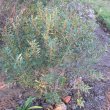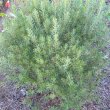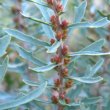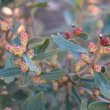| Botanical Name |
|
| Family |
Myricaceae - The wax-berry family.
|
| Pronunciation |
mor-EL-a kwer-se-FOH-lee-uh |
| Common Name(s) |
English: Wax Berry; Oak-leaf Myrica
|
| Plant Group |
- Shrub A woody plant of relatively low height, having several stems arising from the base and lacking a single trunk; a bush.
|
| Plant Size |
- Small
| Tree | 4m to 8m |
| Shrub | 50cm to 75cm |
| Perennial/ground cover | 10cm to 20cm |
| Bulb | 20cm to 30cm |
| Succulent | 10cm to 20cm |
|
| Position |
- Partial Shade The area is in shade for part of the day and in full sun for part of the day.
- Sun The area is in full sun for all or most of the day, all year round.
|
| General Information |
- Drought Tolerance: High The plant is well adapted to arid conditions; it can survive long periods of drought and high temperatures without extra water.
- Evergreen Plants that have leaves all year round.
- Frost: Half-hardy The plant is able to survive low temperatures and some frost but requires protection against severe frost.
- Sand tolerant Plants adapted to survive in nutrient poor, very sandy soils.
- Water Wise Plant species originating from low rainfall regions that require less water to survive and thrive than other plant species.
- Wind Tolerant Plants able to withstand the effect of strong winds.
|
| Specific Information |
Morella Quercifolia (previously known as Myrica quercifolia) has attractively lobed, oak-leaf-shaped leaves and is a useful foliage plant. It used for soil stabilisation and re-vegetation projects but grows well in the garden and is particularly useful for sandy soils. Less than a meter tall, it may spread horizontally with enthusiastic abandon. Both sexes of the plant are needed for the production of the small, blue-ish, waxy berries which are eaten by birds. Interestingly, the waxy coating is not wax, but a true fat.
|
| Ad Break |
|
| Flowers |
| Description |
male: reddish-brown catkin-like flowers which open and produce pollen grow from the leaf axils
female: very small, densely clustered on lower parts of stems
|
| Season |
- Autumn to Winter Plants will seldom bloom for the entire season as given in the list, but should flower during a period within these parameters.
|
| Colour |
|
| Growth Rate |
- Moderate to Fast Specifying growth rate can be very misleading as there is considerable variation of growth rate depending on type and species of plant, available water, supplementary feeding, mulching and general care, as well as the plants suitability and adaptability to the garden environment.
|
| Plant Uses |
- Attracts bees, butterflies or other insects This plant attracts insects which can be food for birds or other creatures in your garden.
- Attracts Birds This plant will attract birds.
- Border A strip of ground, at the edge of a driveway or path in which ornamental plants or shrubs are planted.
- Filler Either a fast growing tree or shrub used temporarily to fill in an area while the permanent plants grow to a desired size, or a plant used to fill gaps in borders or beds.
- Foliage Plant Plants grown because their foliage is colorful or unique. Many of these plants have insignificant flowers.
- Ground Cover Low-lying plants that spread fast, require minimal maintenance, and cover large expanses or bare areas between bulbs or shrubs. They provide protection from erosion and drought and improve the visual appearance of the garden.
- Pioneer for new gardens A very fast growing plant, able to withstand hardship, that can be used to populate land that has recently been cleared of natural vegetation. These plants pave the way for slower-growing species by adding nutrients to the soil and creating leaf litter.
- Rock Garden An area constructed of larger rocks, arranged naturally, to emphasise the use of stones as a main element. Generally plants used do not need a lot of care.
- Stabilize Banks Plant is used to prevent soil erosion because their roots will form a mat that stabilizes the soil and keeps it from washing away in heavy rains.
- Suitable for coastal gardens Plants adapted to dry, sandy soil, forceful wind, limited rainfall and intense sunlight.
- Suitable for smaller gardens Such plants do not have invasive root systems, remain small or controllable and can often be grown in containers.
- Wild Garden An indigenous garden planted for the benefit of wildlife and birds. Provides food, water, a variety of mini-biomes and no poisonous chemicals are used.
|
| Distribution and Habitat |
in the Western, Northern, North West and Eastern provinces, on sand flats, slopes, among rocky outcrops, in fynbos and Albany thicket and near streams
|
| Planting Suggestions |
Morella quercifolia will grow in sandy or loamy soils in sun or partial shade. Water, feeding and mulch will encourage healthy growth. Trim to keep neat if desired. It can be propagated from seed or by cuttings taken in spring using semi-hardwood and a rooting hormone.
|
| Lorraine's Garden Notes |
As I have only a male plant, I don't get to watch the development of the female plant. To get the full benefit of this interesting species, try to plant 3 or more specimens to ensure you have a mix of male and female plants - unless there somebody out there who knows how to tell the difference when they are small? That would be useful.
Anyone got seeds of Morella cordifolia?
|
| Medicinal Uses |
The leaves were used by early Cape settlers as a remedy for the relief of stomachache.
|
| Ad Break |
|










Discuss this plant
Share knowledge, ask a question or give an experience.